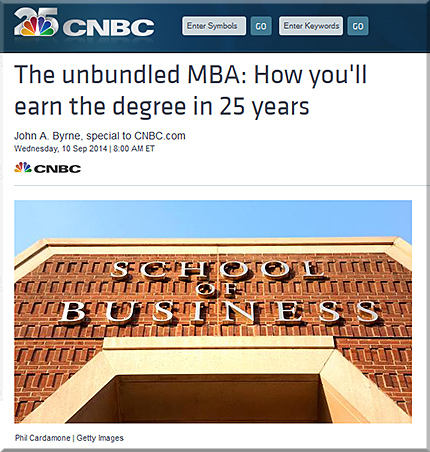Ed-Tech advances poised to revolutionize higher ed from all angles — from evolllution.com by Michael Horn
Excerpt:
There’s a flip side to unbundling, however, that receives far less attention. As a service’s architecture becomes modular, its performance becomes determined by the raw performance of its subcomponents, which consequently become interdependent — or re-bundled — as the entities making these subcomponents need to wring every ounce of performance out of them. In other words, as one stage becomes modular, an adjacent stage becomes interdependent.
In education, as elements such as content become unbundled, there will exist a need for subcomponents that bundle together — coaching, mentoring, communities, personal learning plans and employer connections, for example, as these areas are critical for student success, but the ways in which they fit together are not yet well enough understood such that there can be clear standards at their various interfaces. Standalone, modular solutions in these areas will struggle to succeed. Creating standards at their interfaces before we know what the standards should be will similarly suffer.
..
Similarly, too few are thinking about how to help students make sense of and navigate this emerging, unbundled world and integrate the modular pieces together in ways that help them carve out a coherent and sensible life path. This is critical because it appears that in a personalized learning future, every single learner will have a custom-fit educational pathway.
Bundling and Re-bundling — from elearnspace.com by George Siemens
Excerpt:
There are a few things wrong with the idea of unbundling in education:
1. Unbundling is different in social systems than it is in a content only system. An album can be unbundled without much loss. Sure, albums like The Wall don’t unbundle well, but those are exceptions. Unbundling a social system has ripple effects that cannot always be anticipated. The parts of a social system are less than the whole of a social system. Unbundling, while possible in higher education, is not a zero sum game. The pieces on the board that get rearranged will have a real impact on learners, society, and universities.
2. When unbundling happens, it is only temporary. Unbundling leads to rebundling. And digital rebundling results in less players and less competition. What unbundling represents then is a power shift. Universities are today an integrated network of products and services. Many universities have started to work with partners like Pearson (ASU is among the most prominent) to expand capacity that is not evident in their existing system.
.
Rebundling is what happens when the pieces that are created as a sector moves online become reintegrated into a new network model. It is most fundamentally a power shift. The current integrated higher education system is being pulled apart by a range of companies and startups. Currently the university is in the drivers seat. Eventually, the unbundled pieces will be integrated into a new network model that has a new power structure. For entrepreneurs, the goal appears to be to become part of a small number of big winners like Netflix or Google. When Sebastian Thrun stated that Udacity would be one of only 10 universities in the future, he was exhibiting the mentality that has existed in other sectors that have unbundled. Unbundling is not the real story: the real issue is the rebundling and how power structures are re-architected. Going forward, rebundling will remove the university from the drivers seat and place the control into the re-integrated networks.
————
Addendums:
- Unbundling Versus Designing Faculty Roles (PDF) 1MB — from this page at acenet.edu
This paper explores current conversations about the changing role of college and university faculty, the so-called “unbundling” or “disaggregation” of the faculty role.
- The unbundled MBA: How you’ll earn the degree in 25 years — from cnbc.com by John Byrne
Addendum on 9/17/14:
Ed tech’s next wave rolls into view — from by Roger Novak
Excerpt:
If the second wave was about the unbundling of colleges and providing learning as a service, the third wave of companies will be involved in reassembling educational component pieces from various sources to help make students’ learning portfolios more meaningful to both individuals and employers. While we are starting to see colleges taking similar steps to become more student-centered, private-sector companies can act nimbly to fill gaps and create new technologies to help accomplish these goals.









